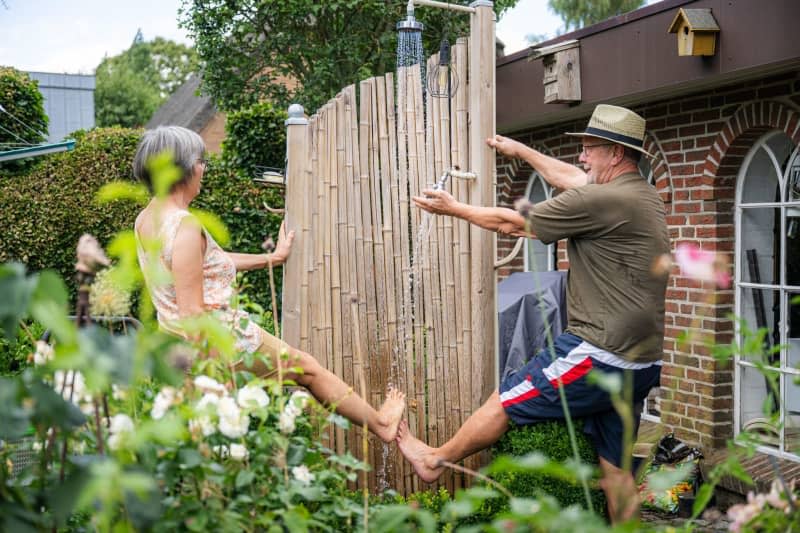Stay active and put your feet up: 7 ways to ease swelling in the heat

Whooh, man it's hot! The summertime heat really puts a strain on the body, especially if you are one of those people whose feet and ankles swell up and feel heavy on hot days.
What causes this? "When it's warm the blood vessels in the body expand," German pharmacist Ursula Funke explains. Blood circulation slows down and the veins lose their elasticity, which in turn can allow fluids to leak into the tissue of your feet and legs. At the same time, the veins struggle to pump blood back to the heart, with fluids pulled down into the legs by gravity, and the swelling starts.
"Women are more prone to this than men," Funke says, explaining that women have weaker connective tissue. So with constant heat the veins have less support.
If swollen legs and feet is a recurring problem, it is best to seek medical help to try to find the causes as this could be a sign of serious ailments of the heart, liver or kidney. But for those who only suffer from heavy, swollen feet and puffy ankles in hot weather, here are seven tips that might help:
1. Stay active - even at the office
"People often don't exercise enough," says alternative practitioner René Gr?ber who is based in northern Germany. Especially when it's hot, many tend to stay put to avoid breaking into a sweat.
However, movement triggers blood circulation in the body, which can result in a better feeling in the legs.
For those in desk jobs, it can help to stand up and walk around several times a day, for example while on a call.
While sitting at your desk, "keep wiggling your feet and toes," pharmacist Funke advises. With the big toe of one foot, "draw" a large eight on the floor, then do the same with the other foot.
Taking a walk in the evening or doing some non-strenuous fitness training also keeps your circulation going - which benefits your legs and feet.
2. Go cycling - but on your back
An exercise which doesn't require any equipment, lie on your back during a quiet moment and pedal with your legs up in the air, as if you were riding a bike. Keep going for at least 30 seconds.
If you can't - or don't want to - lie on the floor, you can draw circles with your feet while standing. Lift one leg and move your foot in circles from the ankle. Repeat with the other foot.
3. Put your feet up
Alternating between elevating your legs and moving them is the perfect combination against swollen feet and ankles, Funke says. If you put your legs and feet up, blocked-up fluid can drain off.
In bed at night, try to elevate your legs slightly, for example by putting a pillow under your ankles, so that your feet are slightly higher than your head.
4. Refresh your legs with a splash of cold water
Gr?ber recommends a cold water treatment for the lower legs twice a day to reduce swelling on hot days. Use your shower hose to spray cold water on your legs, starting with the left front from the foot up, followed by the left back from the foot up. Repeat for the right leg.
For those with cold feet, the practitioner recommends warming them up first, for example by taking a walk.
5. Stay hydrated
Drinking lots of fluids makes it easier for the blood to circulate through the body. At the same time, though it might sound contradictory, it helps to drain the body tissue.
Beneficial liquids include mineral water and herbal teas. It's better to abstain from alcohol, especially since on hot days it can lead to circulatory problems.
6. Eat light food
Avoid heavy and high-calorie meals, which in the heat can put unnecessary stress on the body - including your legs and feet. Light whole foods with lots of fruits and vegetables are ideal on hot days.
7. Wear comfortable shoes - or none at all
High heels put extra strain on the veins in your legs in hot weather, while flats and comfortable shoes help to relieve swelling. Gr?ber recommends that you take your shoes off and go barefoot as much as you can during the day.
If you have a garden, start the day by taking a barefoot walk across the dewy lawn. "Afterwards, just wipe off the dew and let your feet dry naturally."
If none of these tips help to reduce the swelling, then a good - if not a necessarily comfortable - solution can be compression stockings. These exert pressure on the veins and help to transport blood from the legs back to the heart. "But compression stockings should be only the last means chosen when it's hot," Funke says.


